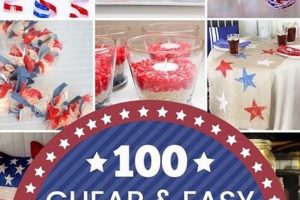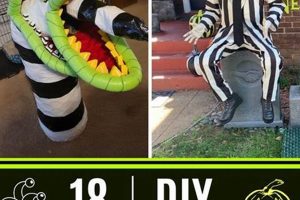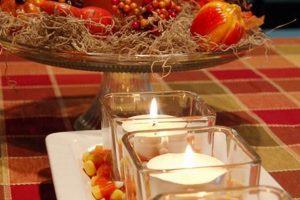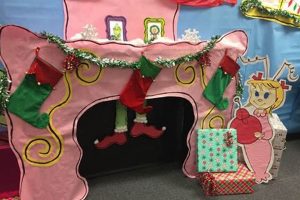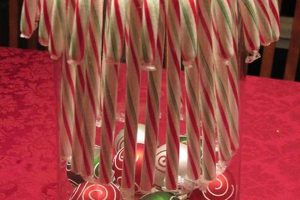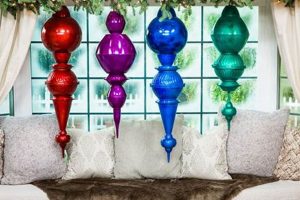Creating personalized decorations inspired by the aesthetic of the film “Beetlejuice” through do-it-yourself projects is a burgeoning trend. Examples include hand-painted signs replicating the film’s iconic sandworm imagery or handcrafted centerpieces incorporating black and white stripes.
This activity provides an avenue for individuals to express creativity and fandom while crafting unique and cost-effective home or event decorations. Its increasing popularity reflects a broader interest in personalized decor and the enduring appeal of the referenced film’s distinctive visual style. The ability to customize each piece ensures that decorations are unique and tailored to individual preferences.
The subsequent sections will explore specific project ideas, material recommendations, and techniques for successful execution of “Beetlejuice”-inspired decorations, facilitating the creation of a themed environment.
Tips for Beetlejuice-Inspired Decoration Projects
This section offers guidance for crafting decorations that evoke the aesthetic of the film “Beetlejuice” through do-it-yourself methods. Adherence to these tips will improve project outcomes and enhance the overall thematic consistency.
Tip 1: Prioritize Black and White Stripes: The film’s visual identity is intrinsically linked to the juxtaposition of black and white stripes. Implement this pattern in various elements, such as painted furniture, fabric backdrops, or accent pieces.
Tip 2: Incorporate Sandworm Motifs: Replicating the sandworms from the film is essential. This can be achieved through sculpting clay figures, painting murals, or creating textured fabric representations.
Tip 3: Utilize Gothic Architecture Elements: The film employs visual cues reminiscent of gothic architecture. Consider incorporating pointed arches, dark wood accents, and wrought iron details into decorations.
Tip 4: Replicate the “Handbook for the Recently Deceased”: Crafting a replica of this book serves as a recognizable and thematic prop. Pay attention to the weathered appearance and distinct typography of the original.
Tip 5: Emphasize the Use of Green and Purple Hues: Introduce splashes of green and purple as accent colors. These provide a visual contrast to the dominant black and white scheme, enhancing the overall aesthetic.
Tip 6: Create a “Netherworld Waiting Room” Vignette: Recreate a portion of the waiting room scene. Utilize vintage furniture, worn textures, and outdated office equipment to achieve the desired effect.
These tips emphasize the importance of understanding and replicating the key visual elements of the source material. Success hinges on careful attention to detail and a consistent application of the film’s distinctive aesthetic.
The following sections will delve into specific project ideas and material selection to further assist in the execution of “Beetlejuice”-inspired decor.
1. Striped Color Palette
The utilization of a striped color palette is fundamental to achieving a recognizable “Beetlejuice decor DIY” aesthetic. Its implementation immediately establishes the film’s visual style within the decorative scheme.
- Dominant Black and White:
Black and white stripes serve as the most recognizable visual cue associated with the film. Their application across surfaces such as walls, furniture coverings, and accent pieces is paramount. For example, painting existing furniture with alternating black and white stripes instantly transforms it into a themed element. The dominance of this pattern ensures immediate recognition and adherence to the desired theme, solidifying its presence in “beetlejuice decor diy”.
- Accent Colors – Green and Purple:
While black and white establish the primary aesthetic, strategic inclusion of green and purple hues is essential for visual balance and thematic accuracy. These colors, present in various scenes and characters, provide accentuation. For example, using green and purple lighting or incorporating accessories in these colors prevents the decor from becoming visually monotonous. Their presence complements the main striped scheme for an effective “beetlejuice decor diy”.
- Varying Stripe Widths and Orientations:
Introducing variations in stripe width and orientation adds visual interest and prevents the decor from appearing static. Alternating between wide and narrow stripes, or utilizing vertical, horizontal, and diagonal orientations, enhances the aesthetic complexity. An example could be a horizontally striped rug contrasted with a vertically striped wall. This element adds visual dynamism and ensures uniqueness within the broader “beetlejuice decor diy” project.
- Material Selection for Contrast and Texture:
The choice of materials impacts the visual effect of the striped color palette. Combining contrasting textures, such as matte paint with glossy fabrics, adds depth and tactile interest. For instance, a black and white striped velvet cushion placed on a matte black chair enhances the tactile experience and visual richness. This element contributes significantly to the sophistication and sensory impact of “beetlejuice decor diy”.
These facets, when implemented cohesively, ensure a visually striking and thematically accurate “Beetlejuice decor DIY” outcome. The careful selection and application of the striped color palette, along with thoughtful consideration of accent colors, stripe variations, and material choices, contributes significantly to the overall effectiveness of the decoration.
2. Sandworm Representations
The inclusion of sandworm representations is a critical element in achieving a successful “beetlejuice decor diy” theme. These monstrous figures are intrinsically linked to the film’s visual identity and serve as immediately recognizable icons within the decorative landscape.
- Sculptural Renditions
Three-dimensional sandworm sculptures, crafted from materials such as clay, papier-mch, or foam, provide a tangible and visually striking element. These sculptures can range in size from small tabletop decorations to larger, more imposing pieces. The level of detail incorporated, from the segmented body to the menacing teeth, directly impacts the realism and thematic resonance of the representation. Accurate sculptural renditions significantly enhance the visual impact of “beetlejuice decor diy”.
- Mural and Graphic Depictions
Two-dimensional representations of sandworms, such as painted murals or printed graphics, offer a visually impactful and space-efficient alternative to sculptures. These depictions can be applied to walls, furniture, or fabric backdrops. The style of the representation can range from realistic renderings to stylized, cartoonish interpretations, allowing for flexibility in matching the overall aesthetic of the decor. Large-scale murals featuring sandworms act as a central focal point in “beetlejuice decor diy”.
- Textile and Fabric Creations
Sandworm representations can be incorporated into textile and fabric projects, such as pillows, blankets, or wall hangings. The use of textured fabrics, such as faux fur or quilted materials, can enhance the tactile appeal and visual complexity of the representation. Fabric sandworms can be crafted through sewing, knitting, or crocheting techniques, allowing for customization in size, shape, and texture. Textile-based sandworms offer a soft and inviting element within “beetlejuice decor diy”.
- Illuminated Sandworm Elements
Integrating lighting elements into sandworm representations can create a dramatic and visually arresting effect. This can be achieved through the use of LED lights, fiber optics, or translucent materials that allow light to pass through. Illuminated sandworms can serve as accent lighting or focal points, enhancing the overall ambiance of the decor. The choice of lighting color, such as green or purple, can further amplify the thematic connection to the film. Illuminated sandworms add a layer of sophistication and visual intrigue to “beetlejuice decor diy”.
The integration of sandworm representations, regardless of the chosen medium, significantly enhances the thematic consistency and visual impact of “beetlejuice decor diy”. Their presence serves as an immediate and unmistakable reference to the film, contributing to a more immersive and engaging decorative experience. Skillful crafting and strategic placement of these elements are essential for a successful implementation.
3. Gothic Architectural Elements
The incorporation of Gothic architectural elements within “beetlejuice decor diy” contributes significantly to the authenticity and atmospheric quality of the theme. The film’s visual language draws heavily upon Gothic aesthetics, establishing a sense of the macabre and the supernatural, mirroring the narrative’s exploration of the afterlife and the bizarre. The effect of integrating these elements is to create a visually compelling and immersive environment, transcending simple decoration to evoke a tangible feeling of the film’s world.
The importance of Gothic elements stems from their inherent symbolism and association with the uncanny. Pointed arches, for instance, can be replicated through constructed backdrops or incorporated into furniture design, creating a sense of verticality and unease. Dark wood accents, such as repurposed frames or decorative moldings, add a layer of aged elegance and contribute to the overall somber mood. Wrought iron details, whether in the form of candelabras or decorative screens, provide a sense of intricate darkness. An example can be seen in crafting pointed archways from cardboard and painting them with a dark, textured finish to mimic stone. Another would be repurposing an old, darkly stained wooden frame to surround a “Beetlejuice” movie poster. The practical significance lies in the ability of these elements to instantly transform a space, creating a visceral connection to the film’s thematic content.
In conclusion, Gothic architectural elements are not merely decorative additions but rather essential components in creating an authentic and immersive “beetlejuice decor diy” experience. While challenges may arise in sourcing or crafting these elements, the resulting atmosphere significantly enhances the decorative project. By understanding and implementing these design principles, individuals can effectively capture the essence of the film’s visual style and translate it into a tangible and evocative decorative environment.
4. Handbook Replication
The replication of the “Handbook for the Recently Deceased” serves as a significant component within “beetlejuice decor diy,” directly influencing the thematic fidelity and immersive quality of the decorative scheme. The “Handbook” acts as a tangible artifact from the film’s universe, providing a recognizable and contextually relevant prop that reinforces the overall aesthetic. Its presence elevates the decoration beyond mere visual imitation, introducing a narrative element that enriches the experience. For example, crafting a replica of the “Handbook” and placing it prominently within a themed room immediately establishes the “Beetlejuice” connection and invites closer inspection, increasing engagement with the decor. The act of replicating the handbook reinforces the theme and increases the immersive outcome for any DIY decorator trying to invoke the film’s theme. Neglecting this replication diminishes the authenticity and contextual depth of “beetlejuice decor diy”.
Practical applications of “Handbook Replication” range from simple paper mache creations to more elaborate, leather-bound versions utilizing aging techniques for added realism. Digital printing and binding methods can be employed for accurate reproduction of the book’s cover and internal pages. The level of detail invested in the replication directly correlates with its impact on the overall decor. The inclusion of handwritten notes or sketches within the replica can further enhance its authenticity and provide a unique touch, demonstrating personal commitment and increasing the viewer’s perception of the “beetlejuice decor diy” as a labour of love.
In conclusion, “Handbook Replication” is a crucial element in achieving successful “beetlejuice decor diy.” While the creation of a convincing replica may present challenges related to material sourcing, crafting skills, and adherence to design authenticity, the resulting impact on the thematic coherence of the decor outweighs these difficulties. Effectively integrating the “Handbook” enhances the overall aesthetic and provides a narrative focal point, ensuring the decoration effectively captures the essence of the film’s distinctive visual style and themes.
5. Netherworld Vignettes
The creation of Netherworld Vignettes within “beetlejuice decor diy” is paramount to establishing an immersive environment that reflects the film’s distinctive portrayal of the afterlife. These small, staged scenes encapsulate the bureaucratic and surreal aspects of the Netherworld, serving as focal points that enhance the thematic consistency and visual impact of the overall decor.
- Waiting Room Ambiance
Replicating the waiting room scene from the film serves as a foundational element for Netherworld Vignettes. This involves the utilization of outdated office furniture, worn textures, and faded color palettes to evoke a sense of bureaucratic stagnation. Details such as vintage telephones, overflowing ashtrays, and stacks of paperwork contribute to the authenticity of the scene. An example includes the strategic placement of a rotary phone next to a dilapidated desk laden with forms, creating a tangible representation of the Netherworld’s tedious processing procedures. The accurate depiction of this environment is essential for setting the tone and establishing a recognizable connection to the film within the overall “beetlejuice decor diy” theme.
- Bureaucratic Paperwork and Forms
The inclusion of fabricated bureaucratic paperwork and forms is crucial for reinforcing the Netherworld’s emphasis on process and regulation. These can range from “Recently Deceased” questionnaires to application forms for various afterlife services. The use of aged paper, illegible handwriting, and absurd bureaucratic jargon enhances the comedic and satirical aspects of the Netherworld. An example could involve the creation of a form requesting permission to haunt a residence, filled with nonsensical questions and requiring multiple levels of authorization. These detailed elements add depth and narrative richness to “beetlejuice decor diy”, inviting viewers to engage with the theme on a more interactive level.
- Macabre Office Supplies
The incorporation of macabre office supplies, such as skeletal staplers, skull-shaped paperweights, and bone-handled letter openers, introduces a subtle layer of dark humor and reinforces the theme of death and the afterlife. These items serve as both functional objects and decorative accents, seamlessly blending the mundane with the morbid. For instance, a stack of papers held together by a stapler with a miniature skull attached adds a touch of the surreal to an otherwise ordinary office setting. Integrating such details elevates “beetlejuice decor diy”, providing an engaging twist on the commonplace and contributing to the overall atmosphere of dark whimsy.
- Unusual Case Files and Documentation
The creation of unusual case files and documentation, pertaining to the recently deceased or supernatural occurrences, adds a narrative dimension to Netherworld Vignettes. These files can include newspaper clippings of ghostly sightings, coroner’s reports detailing bizarre deaths, or handwritten accounts of paranormal experiences. The use of aged paper, cryptic annotations, and unsettling imagery enhances the sense of mystery and intrigue. An example involves compiling a file on the Maitlands’ death, complete with fabricated police reports and witness statements detailing their ghostly presence. The presence of these details engages the viewer and enhances immersion.
The construction of Netherworld Vignettes demands a careful balance between thematic accuracy and creative interpretation. By meticulously replicating the details of the film’s Netherworld and incorporating unique elements of dark humor and the macabre, “beetlejuice decor diy” can effectively capture the spirit of the film and create an engaging and memorable decorative experience.
Frequently Asked Questions
This section addresses common inquiries and clarifies potential misconceptions regarding the creation of decorations inspired by the film “Beetlejuice” through do-it-yourself methods.
Question 1: What are the essential colors for a “Beetlejuice” themed decoration?
The core color palette comprises black and white, with green and purple serving as accent colors. The strategic use of these hues is critical to replicating the film’s visual identity.
Question 2: How important is the inclusion of sandworm imagery?
Sandworm representations are highly important. Their presence is an immediately recognizable reference to the film’s monstrous element, enhancing the theme.
Question 3: Are Gothic architectural elements necessary, or merely optional additions?
Gothic architectural elements are integral. Their integration contributes significantly to the film’s unique visual style and to the atmosphere.
Question 4: To what extent should the “Handbook for the Recently Deceased” be replicated?
The closer to reality the “Handbook” resembles, the better the theme becomes. A convincing replica acts as a pivotal prop and enhances thematic consistency.
Question 5: What constitutes a successful “Netherworld Waiting Room” vignette?
A convincing “Netherworld Waiting Room” features outdated furniture, worn textures, and bureaucratic paperwork, effectively capturing the film’s surreal portrayal of the afterlife.
Question 6: Is it necessary to adhere strictly to the film’s aesthetic, or is creative interpretation permissible?
While adherence to core visual elements is crucial, creative interpretation and personalized touches can enhance the uniqueness and impact of the decorations, provided they remain thematically consistent.
The answers provided offer clarification on key aspects of “Beetlejuice Decor DIY”. Understanding and implementing these principles will contribute to the creation of successful and thematically accurate decorations.
The subsequent article sections will explore common errors and best practices to further assist in “Beetlejuice Decor DIY”.
Beetlejuice Decor DIY
This exploration of “beetlejuice decor diy” has emphasized the importance of key visual elements: the striped color palette, sandworm representations, Gothic architectural details, replication of the “Handbook for the Recently Deceased,” and the construction of Netherworld vignettes. Successful projects require a consistent and thoughtful application of these components to create an authentic thematic environment.
The discussed methods represent a framework for effective design and construction. Continued development in thematic decorating lies in exploring further the film’s nuances, allowing enthusiasts to deepen their craft and generate increasingly imaginative and impactful results. Successful “beetlejuice decor diy” requires thoughtful application of themes and design.


